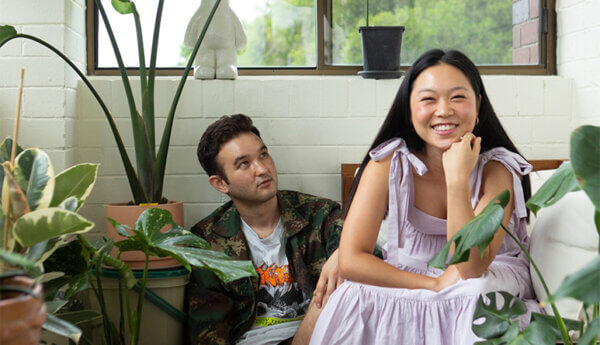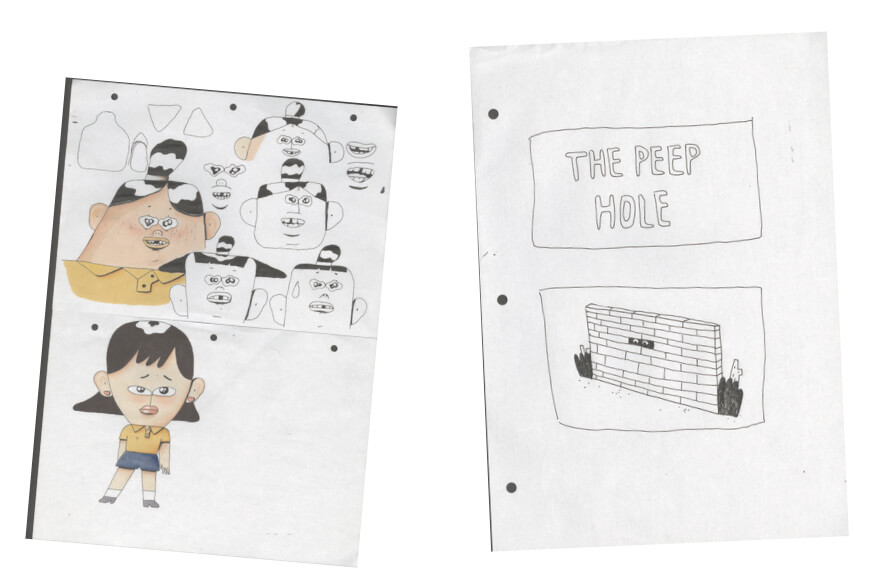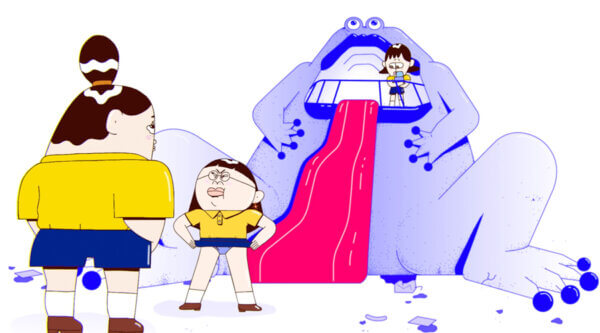A Conversation with Haein & Paul
Today on Skwigly we meet Sydney-based animation duo Haein Kim and Paul Rhodes, known collectively as Haein & Paul.
On top of a growing portfolio of standout commercial work for MTV, Uniqlo, Oppo and Libresse/Bodyform’s Womb Stories campaign, the pair have made waves in recent years with their University of Technology Sydney graduation short Peepin. A darkly absurd yet curiously authentic and relatable story of playground politics and lost innocence whose festival screenings including Pictoplasma, KLIK, GIRAF and the prestigious AACTAs (The Australian Academy of Cinema and Television Arts Awards), Peepin draws on recurring elements of the pair’s output, notably its keen sense of vibrant, comics-informed graphical art as well as themes of body image and racial issues that reflect both artists’ experiences growing up in Australia.
To accompany the film’s inclusion in this month’s special Skwigly-curated edition of Cardiff Animation Nights – and to mark their recent signing with UK-based animation powerhouse Nexus Studios – Skwigly chatted with the duo to learn more about their working dynamic, the origins of Peepin and what the future holds.
How did you two get into animation to begin with, and then ultimately come to work together?
Paul Rhodes: I started by doing music videos, playing in bands, then after that we met at uni where we both studied animation.
Haein Kim: I actually originally wanted to be an astronaut. Then I was like “Oh, maybe I’ll do animation instead…”
You can have astronaut as a fallback.
PR: Animation was the easier route.
HK: I don’t know. I still want to be an astronaut. Maybe one day.
So when it comes to the working dynamic itself, do you tend to have the same roles on each project?
PR: I think it varies slightly, but mainly, yeah, we do have things that we’re better at. Haein does all of the character design and I try not to really touch too much of that, because I think she’s really good.
HK: Yeah, when we work together I tend to do character design stuff and Paul does background design. Paul will do the main chunk of the writing and I’ll kind of pipe in and add my little things to it. Then Paul does the first thumbnails and I’ll do a rough animatic. Yeah, I guess that’s kind of the pipeline, Paul does music and sound as well.
PR: Definitely with Peepin it was Haein doing mainly the character design and I headed up the storyboard and writing. From then we kind of shared everything.
HK: Yeah, it’s very collaborative.

Paul Rhodes & Haein Kim
So there are more advantages to working together than the projects you’ve done individually?
HK: Yeah. I like working by myself too though (laughs).
PR: I suppose maybe I’m a little bit more open to collaborating with different people, trying new things. But yeah, Haein probably chugs along by herself a bit better.
HK: Yeah, a bit more of a lone wolf.
I’m curious, how is the animation scene in Sydney these days?
HK: It’s interesting you ask that, because when we graduated this company Flying Bark had just gotten a gig doing the new Ninja Turtles series. So practically everyone in the Sydney animation industry was working on that! We worked there for about a year or two and then left to do our own freelancing stuff. There’s a lot of commercial work and TV stuff, but we want to make more original content.
PR: There are a lot of animators, but I suppose just because of what work is available it’s more your mograph types of content creators. There aren’t too many people who have gone down the path of original content, which is sort of what we’re trying to do. In terms of Australia, I think Melbourne has always been the biggest city for animators but Sydney has definitely popped up in the last few years.
When it comes to developing your style and finding influences, are there any particular artists or movements you look toward?
HK: I’m really inspired by artists and just things around me. In particular artists like Misaki Kawai, who got me looking into the Japanese movement called heta-uma, which I think directly translates to ‘bad but good’. It was a movement in the 70s, an underground manga movement of not being so tied down to realistic renditions of things, but just having a bit more fun and being more playful. I think that’s something that I really gravitate towards, I don’t really want something that looks conventionally attractive or anything like that. I guess we both like off-the-beaten-track a little bit.
PR: Yeah, I think when we make stuff together we sort of push towards having fun or being playful more than trying to be masters of what we do. We look to the DIY comic scene in Sydney a lot, a lot of risograph style stuff.
HK: I think we look at directors as well. I really like the work of Miranda July, she makes films but she also has novels and she’s made an app…her whole philosophy, I think, is to make things with a sense of naivety. That’s what she likes doing, which I really find inspirational.

Peepin development sketches (via haein-kim.net)
So was Peepin a student film?
PR: Yeah, it was our final year film at UTS. We were sort of lucky, we got to put a bit of a powerhouse team together.
Was the university open-minded in embracing the weirdness of it?
HK: We had way more wild ideas before we landed on that one, where they said “No, you can’t do that”!
PR: I guess the answer is yes and no – they did embrace it but there were a lot of things we couldn’t do.
HK: Yeah, we tried to do a film just talking about race, but I think it was a bit too…it was very sensitive.
PR: So yeah, Peepin was the idea we landed on; the ‘safer’ idea!
It is interesting how thorny those sorts of themes are, how you have to navigate them so carefully for them to be considered acceptable contributions to a conversation. I don’t know if this would have been flagged making this film, but even the way you depict a character, visually, has such a problematic history, especially in animation. That’s something I think that people have to be very wary of now. But it’s a shame, if this other idea was going to be about race, that could have been a contribution to a conversation that didn’t get to happen.
HK: This is just my own opinion but I feel like these days, with animation, you don’t know the faces of the artists who are making the short films. I think it’s a completely different story if it’s a person of color telling the story of a person of color and depicting a person of color than, say, a white person telling a story about people of color and drawing them. I think that’s two completely different stories, but because you don’t see who’s doing these drawings – it’s not like actors or singers where you’d see the faces behind the art – I feel that it’s very censored, in a way.
PR: Saying that, I think it was probably not the best idea at the time for that film, but moving forward I think our storytelling skills have matured and it’s definitely something we’re going to revisit or try to have a crack at. I think it’s something that we both feel pretty strongly about and there’s so much to say.
Sort of related to that, I’m finding increasingly that there’s more of an active call for intersectionality in animation, especially as far as how diverse characters are represented. From your perspectives, when it comes to things you watch or have worked on, do you feel that that’s improving?
HK: It’s a can of worms, honestly. I think it’s so heated and so sensitive right now, just toeing the line of representing everyone and wanting to be respectful, but companies don’t want to be called out or cancelled so are so scared to do anything. It’s just something that we’re gonna have to try and navigate and come out with authenticity at the end. I don’t want to lose what we have and I don’t want to water down what we do, it’s just something that we’re trying to figure out.
On the subject of authenticity, while there’s a lot of absurdism in the film what really makes it work is it’s rooted in a pretty authentic schoolyard experience. Did that draw on your own memories?
HK: Yeah, for example at the beginning where Kimmy K, the bully, tries to get Dorian the girl to lick her spit to be her friend – that was a story that was based on my little sister, who had a friend that tried to get everyone to step on her spit; in my mind I misremembered it to be licking the spit. Just really weird stories like that. And my sister Jane used to call me like the meanest names like ‘Fatty Boomba’, ‘Chinaman’, ‘Period Stain’ – just the weirdest insults. That’s why those characters say some pretty quirky things.

Peepin (Dir. Haein Kim & Paul Rhodes)
Then later on in the film we get to this wonderful, insane sequence of the world behind the wall. Can you tell us a bit about coming up with the visuals for that and what they represent?
PR: We researched a lot of porn – anime porn, expansion porn, giantess porn, octopus porn…
HK: My best friend took Paul to a public hookup spot and had to teach him the etiquette. He was quite popular, actually! I wasn’t allowed to go because apparently I’d have scared off the men. But yeah, we just went really hard with the research. Hopefully, that kind of weird wonderfulness is kind of present in that scene.
I guess then the scenario then of finding it behind the wall, that’s another sort of childhood memory – stumbling across things we weren’t meant to come across, like a porn magazine in a forest or something our brains weren’t ready to take in.
HK: I think that’s exactly what we’re kind of going for, seeing something as a child and really not quite comprehending what’s going on. You don’t know what you’re looking at. I think that’s kind of the energy we were trying to get for that scene.
PR: Yeah, I’ve definitely got a few stories like that in my childhood. Like someone pasting up a porno inside the boys locker room so the teachers had to run in and take it all down, just weird things like that.
We talk a lot on Skwigly with filmmakers who deal with themes like libido and body image and anatomy. From what I’ve seen of your other work, they seem like they’re recurring themes to an extent. What would you say is the draw of those themes for you, and why do they pair so well with animation?
HK: For me, personally,I really want to push out work that just represents women – women of colour, women of all different body sizes – because I think it’s so interesting to see. I wasn’t exposed to any of that stuff in my childhood, I never ever saw a person of color in a main role of any sort – if anything, a recurring side character who was always the same body type, really skinny. I don’t think that’s really productive for society, and for women I think we need to see and celebrate all different types of body shapes and ethnicities, so I really push for that in my work. I think not seeing any of that when I was growing up really affected my self-esteem.
PR: I suppose you weren’t really talking about race as much as body type, but for us it’s pretty important to put authenticity on the screen, the things that we observe in everyday life, not recycling what we see looking at cartoons or animation or movies. We kind of have a very strong observational part to our work, whether or not it’s a political thing, it’s just something that we know. That’s where that comes from, from my point of view anyway.
I noticed you (Haein) also worked on Womb Stories, which was a real standout commercial project from last year. How did you get involved with that, and what was the experience like?
HK: I just got contacted by a company called Framestore. They were just like “Do you want to do this thing?” and I said “Okay”! I didn’t really understand the magnitude of how big of an impact it would have on people. And when it came out it was beautiful, I was kind of blown away that I was asked to be part of that project. It was great.
So you’ve been recently signed to Nexus – congratulations! How did you guys cross paths with them?
HK: We work a lot with the studio Mighty Nice, who work a lot with Nexus. Darren Price, who’s the founder of Mighty Nice, he’d been sending our work to people. Nexus saw it and were interested, so yeah, it’s all thanks to Darren really!
PR: Yeah, Darren’s been a bit of a hype man for us, he really enjoyed Peepin when that first came out and he’s helped us open a few doors.
So are there any upcoming projects you’re able to tell us about at all? Or is it all kind of hush-hush at the moment?
HK: We’ve got a few things where we’re waiting to see if they’re gonna kick off, but we can’t really talk about them. Right now, we’re currently working on a joint book; half of it’s going to be Paul’s stuff, half of it mine. My stuff’s just gonna be my illustration work but Paul’s will be like a really long comic kind of thing. But yeah, it’s exciting and it’s going to come out mid year, I think.
See more of Haein & Paul’s work at nexusstudios.com

